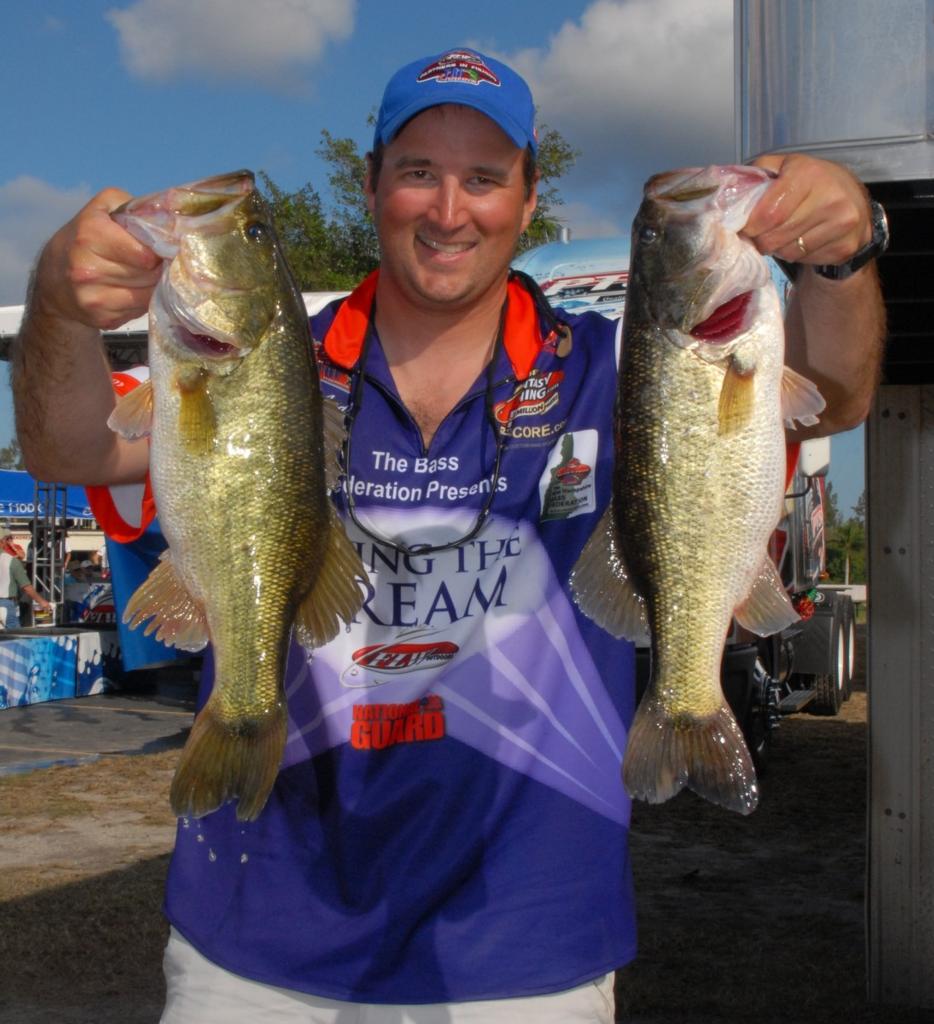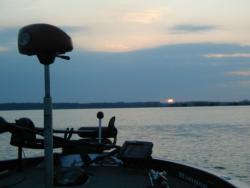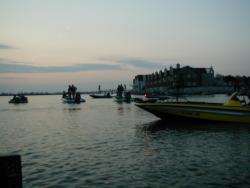Living the Dream: Wheeler Lake, Part 4
Dave Andrews details first day of competition at FLW Series event on Wheeler Lake

————————————-
Editor’s note: This is the fourth piece in a series of journal entries from Dave Andrews, winner of the 2007 TBF National Championship, detailing his second stop on the 2008 FLW Series Eastern schedule. Entries will be published at FLWOutdoors.com throughout the course of the season. As winner of the “Living the Dream” package, offered by FLW Outdoors through The Bass Federation, Andrews had his entry fees paid to test his club skills on the pro tour with the use of a fully wrapped boat and tow package. Andrews will chronicle his adventure in pro bass fishing, having most recently competed on Alabama’s Wheeler Lake. After Andrews has submitted his journal following each FLW Series event, segments will be posted approximately weekly. (Read Part 1, Part 2 and Part 3) (Read his Okeechobee journal; this links to the final entry, which provides links at the top for each preceding part)
————————————-
Wal-Mart FLW Series BP Eastern Division
Stop No. 2: Wheeler Lake
March 26-29, 2008
Tournament competition: day one (Wednesday, March 26)
The morning was considerably milder than the last few days. It was mostly cloudy and breezy as the boats launched at Ingalls Harbor. Usually, at major events such as this, there is a long line to get the boats into the water, but not today. The facility is so spacious and well-designed that it took only 10 minutes or so to find my partner, load his gear and drop the Ranger into the water.
I had a full hour prior to takeoff to prepare my tackle and make a few last-minute changes to my bait selections. I had only two rods strapped to the front deck, both rigged with Rat-L-Traps, one chartreuse and one red-shad. When the boats started off promptly at 7 a.m., they went out quick, and in no time my number was called.
I zipped over to the milfoil bed on the Decatur Flats and idled over the shallow stump rows until the water dropped to 4 or 5 feet. On my best part of the weedline, there was a fallen tree that stuck about a foot and a half out of the water during the last practice day. On Wednesday morning, it was covered  with water. I had punched the spot into my GPS, so I knew I was on the right spot, but clearly the water had come up quite a bit in the prior 36 hours.
with water. I had punched the spot into my GPS, so I knew I was on the right spot, but clearly the water had come up quite a bit in the prior 36 hours.
When I was catching fish on the flat, I was constantly ripping the Trap out of the milfoil, triggering bites. But at the start of competition, the Trap rode freely over the top of the grass. Five or six other boats worked along in close quarters in the milfoil patch. Occasionally an angler would hook a fish and lift it into the boat.
About 10 minutes after I started, I caught a 13-inch keeper on the chartreuse Trap. My partner soon had his first keeper. We rotated around the other boats and kept slinging the Rat-L-Traps. I picked up another largemouth that barely measured and one that fell just short of the 12-inch minimum size. After about an hour, I had seen enough. I idled back out to the channel and pointed the nose of the “Living the Dream” rig south and headed for the bluffs.
I pulled up on the first available section of bluff that I had caught fish on in practice. I noticed several wrapped boats dotting the shoreline all along the steep bluff walls. I thought I would have this water pretty much to myself. Apparently I thought wrong. I fished fast down the shoreline. It was cloudy and breezy and it felt like there should be a good bite. I quickly picked up two largemouths on the red-shad Trap. These were small fish, just barely keepers. Tournament boats zipped in and out all around me. My fifth keeper came at about 9:30 a.m.
I had fished down a section of bluff and came upon another boat working toward me. We met at a dock and each of us pitched a jig up under it. I felt a tick on my line and set the hook. A decent keeper largemouth came flying out of the water, and I flipped it into the boat, strapped my rod down and pulled the trolling motor up.
I moved down a stretch and picked a piece of shoreline that offered 100 yards of fishing between boats. There must have been 40 boats or so on the two-mile section of bluffs that constituted my best water in practice. In three days of practice here, I barely saw another boat on these bluffs. Where did they come from?
I kept my head down and just fished, trying not to focus on the increased pressure my best area was receiving. My mettle was severely tested when I came upon a boat fishing up the shoreline that I was fishing down. We came nose to nose, and I was about to ask the angler in the other boat if he wanted to turn back and re-fish his water or switch with me and head up the bank. Suddenly he set the hook and called for the net; his co-angler didn’t hear him at first, but when the fish jumped, he hollered again  for the net, and soon a 7-pound bass was netted and safely in his boat. The action happened not more then 20 feet away from me. The other angler was Andy Morgan, and the fish would turn out to be one of the biggest of the day come weigh-in time.
for the net, and soon a 7-pound bass was netted and safely in his boat. The action happened not more then 20 feet away from me. The other angler was Andy Morgan, and the fish would turn out to be one of the biggest of the day come weigh-in time.
I continued down the shoreline, looking for a big bite and switching things up with a 1/2-ounce football jig crawled along the rock bluffs, but only a few small keepers would fall for the jig. Before I knew it, it was noon and my time was getting short. The weather had changed, as the sun shown brightly and the wind had let go. Temperatures climbed into the upper 60s, and I was forced to take off my winter clothes.
The banks continued to be hammered by tournament boats. The Rat-L-Trap no longer felt like a good option, so I switched to a ¼-ounce Gambler Giggy Head with a black Sweebo worm and pitched it around the dock poles, thinking the bass might be seeking refuge from the sun and the pressure under the shady piers. A decent keeper, maybe 2 pounds, bit the worm. I set and called for the net, but the fish jumped right near the boat, shaking free of the hook. The largemouth actually hit the side of the boat before falling back into the water and escaping.
I caught a few small keepers and culled a few ounces with the worm. Twice I felt a solid hit and my rod bent double on the hook-set. One fish turned out to be a 10-pound channel catfish, and the other fish was a drum. Late in the day, I picked up the Trap and hooked a good smallmouth, only to have it jump and throw the hook. My frustration was about to bubble over. It clearly wasn’t my day.
With only an hour left in the day, I decided to head back to the Decatur Flats and finish the day working the milfoil bed where I had started. It was a good decision, but I was too far behind to really save my day. I boated three keepers and culled up a few ounces here. My partner, also throwing a lipless rattling crankbait, picked up just one keeper, but it was a solid 3-pound largemouth.
All too soon we had to check in, and then came the painfully long wait in line to weigh my small limit. When my time came, my five fish weighed a pathetic 6 pounds, 4 ounces and left me way back in the pack. Most of the pros had their limits, and the average bag was about 9 pounds. The leader, Jack Deeds, had just over 18 pounds. My roommate Scott Leppanen weighed in over 11 pounds and sat in eighth place on the co-angler side.
I was extremely disappointed with my day and kept wondering what happened to the good fish that I had found in practice. I figured the increase in boat traffic and angling pressure had put the bite off. It wasn’t until later that evening, talking with the other pros in the boatyard, that it became clear what really changed my fate that day.
Thirty-five miles north of Decatur, near the Huntsville Bridge, the divers from the body-recovery unit were still searching for the jumper from a few days before. They were having a heck of a time with all of the current and muddy water. Word had it that they requested that power generation be slowed until they recovered the body. This explained why the water came up nearly 2 feet overnight and why I never saw the current moving along the bluffs the way I did in practice. I suppose it also explained why my Rat-L-Trap caught only a few small keepers, but the bottom line is that I really stunk on opening day. I didn’t make the proper adjustments and put myself in a big hole for the rest of the tournament.
————————————-
Editor’s note: Stay tuned for Part 5 of Andrews’ adventure on Wheeler Lake, in which he’ll write about the second day of competition.
————————————-